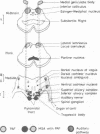Abstract
Brain stem potentials from three groups of patients, namely those with pure progressive autonomic failure, Parkinson's disease and multisystem atrophy with progressive autonomic failure (Shy-Drager syndrome) were compared with each other and a group of normal subjects. In virtually all the patients with multisystem atrophy with progressive autonomic failure the brain stem potentials were abnormal in contrast to normal findings with Parkinson's disease. The closely associated group of patients with progressive autonomic failure alone also revealed no abnormalities of the BAEP. This separation of the two groups, Parkinson's disease and progressive autonomic failure from multisystem atrophy with progressive autonomic failure is important clinically as multiple system atrophy of the Shy-Drager type has extra-pyramidal features closely resembling Parkinsonism or a late onset cerebellar degeneration. From the abnormalities of the brain stem response in multisystem atrophy with progressive autonomic failure, it is clear that some disruption of the auditory pathway occurs in the ponto-medullary region as in nearly all patients there is a significant delay or reduction in the amplitude of components of the response generated beyond this region. The most likely area involved is the superior olivary complex.
Full text
PDF











Images in this article
Selected References
These references are in PubMed. This may not be the complete list of references from this article.
- Achor L. J., Starr A. Auditory brain stem responses in the cat. II. Effects of lesions. Electroencephalogr Clin Neurophysiol. 1980 Feb;48(2):174–190. doi: 10.1016/0013-4694(80)90302-8. [DOI] [PubMed] [Google Scholar]
- Bannister R., Ardill L., Fentem P. Defective autonomic control of blood vessels in idiopathic orthostatic hypotension. Brain. 1967 Dec;90(4):725–746. doi: 10.1093/brain/90.4.725. [DOI] [PubMed] [Google Scholar]
- Bannister R., Oppenheimer D. R. Degenerative diseases of the nervous system associated with autonomic failure. Brain. 1972;95(3):457–474. doi: 10.1093/brain/95.3.457. [DOI] [PubMed] [Google Scholar]
- Bodis-Wollner I., Yahr M. D. Measurements of visual evoked potentials in Parkinson's disease. Brain. 1978 Dec;101(4):661–671. doi: 10.1093/brain/101.4.661. [DOI] [PubMed] [Google Scholar]
- Buchwald J. S., Huang C. Far-field acoustic response: origins in the cat. Science. 1975 Aug 1;189(4200):382–384. doi: 10.1126/science.1145206. [DOI] [PubMed] [Google Scholar]
- Ehle A. L., Stewart R. M., Lellelid N. E., Leventhal N. A. Normal checkerboard pattern reversal evoked potentials in parkinsonism. Electroencephalogr Clin Neurophysiol. 1982 Sep;54(3):336–338. doi: 10.1016/0013-4694(82)90182-1. [DOI] [PubMed] [Google Scholar]
- Ell J., Prasher D., Rudge P. Neuro-otological abnormalities in Friedreich's ataxia. J Neurol Neurosurg Psychiatry. 1984 Jan;47(1):26–32. doi: 10.1136/jnnp.47.1.26. [DOI] [PMC free article] [PubMed] [Google Scholar]
- Gilroy J., Lynn G. E. Computerized tomography and auditory-evoked potentials. Use in the diagnosis of olivopontocerebellar degeneration. Arch Neurol. 1978 Mar;35(3):143–147. doi: 10.1001/archneur.1978.00500270025006. [DOI] [PubMed] [Google Scholar]
- Graham J. G., Oppenheimer D. R. Orthostatic hypotension and nicotine sensitivity in a case of multiple system atrophy. J Neurol Neurosurg Psychiatry. 1969 Feb;32(1):28–34. doi: 10.1136/jnnp.32.1.28. [DOI] [PMC free article] [PubMed] [Google Scholar]
- Huang C. M., Buchwald J. S. Interpretation of the vertex short-latency acoustic response: a study of single neurons in the brain stem. Brain Res. 1977 Dec 2;137(2):291–303. doi: 10.1016/0006-8993(77)90340-7. [DOI] [PubMed] [Google Scholar]
- Jewett D. L., Williston J. S. Auditory-evoked far fields averaged from the scalp of humans. Brain. 1971;94(4):681–696. doi: 10.1093/brain/94.4.681. [DOI] [PubMed] [Google Scholar]
- Kevanishvili Z. Sh. Sources of the human brainstem auditory evoked potential. Scand Audiol. 1980;9(2):75–82. doi: 10.3109/01050398009076339. [DOI] [PubMed] [Google Scholar]
- Prasher D. K., Gibson W. P. Brain stem auditory evoked potentials: a comparative study of monaural versus binaural stimulation in the detection of multiple sclerosis. Electroencephalogr Clin Neurophysiol. 1980 Nov;50(3-4):247–253. doi: 10.1016/0013-4694(80)90152-2. [DOI] [PubMed] [Google Scholar]
- Prasher D. K., Sainz M., Gibson W. P. Binaural voltage summation of brainstem auditory evoked potentials: an adjunct to the diagnostic criteria for multiple sclerosis. Ann Neurol. 1982 Jan;11(1):86–91. doi: 10.1002/ana.410110115. [DOI] [PubMed] [Google Scholar]
- Robinson K., Rudge P. Abnormalities of the auditory evoked potentials in patients with multiple sclerosis. Brain. 1977 Mar;100(Pt 1):19–40. doi: 10.1093/brain/100.1.19. [DOI] [PubMed] [Google Scholar]
- SHY G. M., DRAGER G. A. A neurological syndrome associated with orthostatic hypotension: a clinical-pathologic study. Arch Neurol. 1960 May;2:511–527. doi: 10.1001/archneur.1960.03840110025004. [DOI] [PubMed] [Google Scholar]
- Satya-Murti S., Cacace A., Hanson P. Auditory dysfunction in Friedreich ataxia: result of spiral ganglion degeneration. Neurology. 1980 Oct;30(10):1047–1053. doi: 10.1212/wnl.30.10.1047. [DOI] [PubMed] [Google Scholar]
- Sohmer H., Feinmesser M., Szabo G. Sources of electrocochleographic responses as studied in patients with brain damage. Electroencephalogr Clin Neurophysiol. 1974 Dec;37(6):663–669. doi: 10.1016/0013-4694(74)90081-9. [DOI] [PubMed] [Google Scholar]
- Spokes E. G., Bannister R., Oppenheimer D. R. Multiple system atrophy with autonomic failure: clinical, histological and neurochemical observations on four cases. J Neurol Sci. 1979 Sep;43(1):59–82. doi: 10.1016/0022-510x(79)90073-x. [DOI] [PubMed] [Google Scholar]
- Starr A., Achor J. Auditory brain stem responses in neurological disease. Arch Neurol. 1975 Nov;32(11):761–768. doi: 10.1001/archneur.1975.00490530083009. [DOI] [PubMed] [Google Scholar]
- Starr A., Hamilton A. E. Correlation between confirmed sites of neurological lesions and abnormalities of far-field auditory brainstem responses. Electroencephalogr Clin Neurophysiol. 1976 Dec;41(6):595–608. doi: 10.1016/0013-4694(76)90005-5. [DOI] [PubMed] [Google Scholar]
- Stockard J. J., Rossiter V. S. Clinical and pathologic correlates of brain stem auditory response abnormalities. Neurology. 1977 Apr;27(4):316–325. doi: 10.1212/wnl.27.4.316. [DOI] [PubMed] [Google Scholar]
- Thomas J. E., Schirger A. Idiopathic orthostatic hypotension; a study of its natural history in 57 neurologically affected patients. Arch Neurol. 1970 Apr;22(4):289–293. doi: 10.1001/archneur.1970.00480220003001. [DOI] [PubMed] [Google Scholar]
- Tsuji S., Muraoka S., Kuroiwa Y., Chen K. M., Gajdusek C. D. [Auditory brainstem evoked response (ABSR) of Parkinson-dementia complex and amyotrophic lateral sclerosis in Guam and Japan (author's transl)]. Rinsho Shinkeigaku. 1981 Jan;21(1):37–41. [PubMed] [Google Scholar]
- Yaar I. The effect of levodopa treatment on the visual evoked potentials in Parkinsonian patients. Electroencephalogr Clin Neurophysiol. 1980 Nov;50(3-4):267–274. doi: 10.1016/0013-4694(80)90154-6. [DOI] [PubMed] [Google Scholar]



